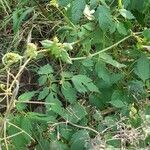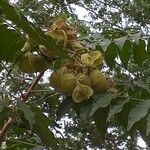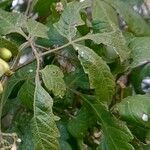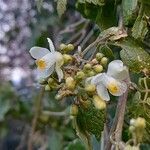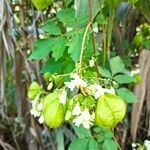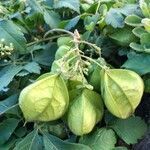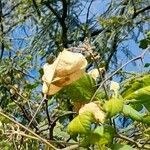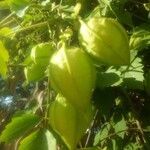Robust herbaceous vines; stems 5-or 6-ribbed, pubescent or glabrate. Leaves biternate; petioles terete, 2-5 cm long; leaflets ovate or oblong to obovate, acumi-nate or obtuse, attenuate at the base, broadly serrate or incised-dentate, mem-branous, 5-8 cm long, 2-3.5(4) cm wide, sparsely pubescent to subglabrous; stipules subulate, small. Thyrses long-pedunculate on a tendril; pedicels 4-6 mm long. Flowers white; sepals 4, the 2 outer small, ovate, hispid, the 2 inner oblong, 6-8 mm long, glabrous; petals glabrous, obovate, attenuate, equal to the sepals, the scale on the inside of the petal oblong-obovate, 4-5.5 mm long, glabrous, with a lateral fold running the full length of the margin, the crest emarginate, the de-flexed appendage slender, villous at the apex, extending nearly or all the way to the base of the flower; disc with 2 slender, elongate, corniform glands, 2-3.5 mm long; staminate flowers with stamens to 8 mm long, united into a tube in the lower half, the tube weakly pubescent, the ovary borne within the staminal tube on a stipe to 1.5 mm long, elliptic, glabrous, the styles 3, the ovary, styles and stipe together to 3 mm long; bisexual flowers with the stamens to 4 mm long, glabrous, the filaments not united at the base, the ovary and style together to 6 mm long, the ovary 3-angled, oblong-elliptic, conspicuously hispid on the angles, the style 3 mm long, 3-branched in the upper half. Fruits elongate, obovate or elliptic capsules, membranous, inflated, acutely 3-angled, 5-6 cm long, acute at both ends, glabrous or nearly so; seeds globose, black, ca. 7 mm diam., the hilum round, conspicuous but much narrower than the body of the seed.
Scrambling vine; stems, leaf axes and peduncles usually rusty-hairy. Leaf rachis 1.5–3.5 cm long; pinnae 3.5–10.5 cm long, 2.5–12.5 cm wide; secondary petioles 0.6–1.5 cm long; leaflets with lamina oblong-ovate or elliptic-ovate, acute or acuminate, irregularly serrate, 2.5–8 cm long, puberulent above, pubescent below; terminal petiolule 4–6 mm long, lateral ones subsessile; petiole 1–6.5 cm long. Panicle corymb-like; peduncle 5.5–14.5 cm long, tendrils 1-paired; pedicels c. 5 mm long. Sepals 2–8.5 mm long and wide. Petals 9–11 mm long, 4.5–5 mm wide, all with scales and crests, white. Disc 2-lobed, erect, horn-like. Fruit ellipsoidal or ovoid, apiculate, 6-ribbed, 5–8 cm long, puberulent. Seed c. 7 mm long and wide; aril saucer-shaped.
Perennial climber, 0.3-8.0 m high. Leaves biternate, stipulate; leaflets lobed, pubescent, upper surface sparsely pubescent, lower surface tomentose, apex acute, margins serrate; petioles up to 70 mm long. Flowers cream-coloured, in axillary thyrses; peduncle with a pair of tendrils at summit, sturdy. Sepals ovate, petaloid. Petals 4, ovate with petaloid appendages, hairy. Stamens 8; filaments free. Ovary villous; style branches filiform, hirsute. Flowering time Apr.-Nov. Fruit an inflated capsule, membranous, up to 66 mm long. Seeds black, globose, with a white, oblong hilum.
A straggling climber. It grows 3-5 m tall. The stems are angular. They are reddish and hairy. The leaves have 3 lobes and are twice divided. They are light green, thin and hairy. The leaf segments are oval and have teeth along the edge. The flowers are 0.8-1 cm across. They are white and have a scent. The fruit is a capsule which is 4.5-6 cm long and 3 sided. It is inflated and yellowish-green. There is a heart shaped scar on the seed.
Leaves biternate; petiole 2·1–7·3 cm. long, pubescent; leaflets with the terminal one 4·5–8·4 × 1·8–3·7 cm. and lateral ones (4)4·5–8·7(11·7) × 1·6–3·3 cm.; lamina ovate, upper surface bright green, sparsely pubescent, lower surface tomentose with occasional long brown hairs on the veins, or both surfaces almost glabrous, apex acute, margin serrate, base attenuate; stipules minute caducous scales.
Petals with 2 anterior and 2 posterior ones ovate bearing petaloid appendages c. 7 mm. long, and joined laterally, those of the posterior petals being apically recurved, passing across the disk, clavate and bearing patent hairs at the tips causing the latter to cohere.
Annual slightly woody climber; stems densely to sparsely hirsute with long brown crisped hairs (c. 2 mm. long) or glabrous; internodes 4–7·6 cm. long.
Flowers 8-10 mm long; abaxial disc-lobes long-corniculate. Inflorescences with several pseudo-whorls. Fruits 3-lobed, ellipsoid, up to 6.5 by 3.5 cm.
Disk produced posteriorly into 2 corniform glands and anteriorly into a short androgynophore (c. 1 mm. long).
Sepals with 2 lateral ones c. 2 mm. long and anterior and posterior ones c. 7 mm. long, ovate, petaloid.
Flowers white or yellow, 7–11 mm. long; pedicels bearing numerous brown scale-like bracts.
Inflorescence an axillary many-flowered corymbose thyrse; peduncle 8–15(20) cm. long.
Ovary hirsute; style-branches filiform, hirsute.
Seeds 5 mm. in diam., globose; hilum oblong.
Fruit 4·4–6·6 cm. long, 3-gonous.
Stamens with free filaments.
